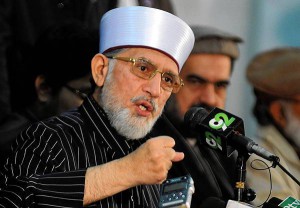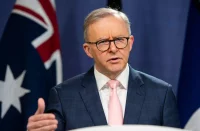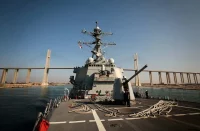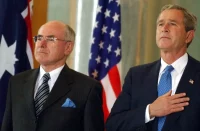It has become a cliché to describe any society, at any crucial stage, passing through one of the most critical and decisive phases of its history. The irony is that no phase, howsoever critical, proves to be completely decisive in the ultimate; for, societies develop through an evolutionary process, and evolution faces many decisive moments. However, each decisive moment does give a peculiar colour to the stage of evolution in which it occurs, and shapes its immediate future until the next decisive moment arrives and unleashes a process of reshaping. In other words, every decisive moment sows seeds of the next decisive moment. This is a well known phenomenon of change, which is continuous and quite difficult to resist. Such seems to be the case with present Pakistan also, which is passing through a critical phase of its history which may turn out to be decisive in future. Challenges are tough and the path is thorny; hopes are alive and prospects are bright, yet much depends upon the will of its people and many other factors to bring about change. Another factor that has to be kept in mind is that it is not necessary that change should occur in all societies in a uniform manner. Factors leading to change and pattern of change very often vary from society to society. Therefore, it cannot be categorically stated, and it is not necessary, that change in Pakistan would occur after the fashion of Arab Sparing. What influences the pattern of change in every society is its peculiar socio-political texture; and Pakistan’s is quite different from those of Arab Countries.

Large scale discontentment over political, social, economic and security concerns looms large in Pakistan at a time when majority of its people are facing the hardships caused by rampant poverty, unemployment, lawlessness and bad governance. Absence of genuine political and electoral process and consequent political subjugation by the political elite are generating a sense of alienation among the masses who, unlike past, now have at their disposal a vibrant media and other sources of information. Having information not only brings awareness but also causes frustration and discontentment. An additional incentive to bring change has been provided by the political changes that have occurred in Middle East and North Africa where millions of people stood up against their respective governments, and in which some of them did succeed in materializing their desire of regime change leading to change of system. Those who are asking for change in Pakistan also see in the Arab Spring hope for change, and have engaged in drawing parallels between those countries and Pakistan. However, we cannot run away with such conclusions without taking into account the peculiar socio-political conditions of Pakistan, its peculiar social texture, low level of homogeneity, its history, its geographical location, and the covert involvement of foreign powers in its internal politics. We cannot reach any sound conclusion without raising critical questions which are typical to Pakistan. For instance, can Pakistan absorb successfully any change brought about by such ‘spring’ given its historical experience and heterogeneity? Will its military allow such a change to occur? Will such a change, if it occurs, keep foreign powers (regional and extra-regional) form directly intervening in Pakistan to seize its Nuclear Weapons? Will Pakistan be able to escape the situation which Syria is facing? These are the critical questions which lend a broad perspective to our present study, and allow us to analyze the prospects of ‘spring of change’ to occur in Pakistan. It would also allow us to keep study focused on drawing similarities and dissimilarities between Pakistan and those countries without allowing for those factors which are not typical to Pakistan.
Before we go on discussing whether or not the domino effect of Arab Spring will hit Pakistan, it appears plausible to have an understanding of those factors and circumstances which led to violent popular uprisings and eventually to change of regime.
The underlying causes of these uprisings varied from country to country. There has of course been no uniform pattern designed for bringing out desired changes in the desired manner. What led the international media to call this phenomenon ‘Arab Spring’ was not only the fact that Arabs, in all countries, rose up against decades-long dictatorships, but also similarity in pattern of protests in all countries. The umbrella term thus used does ‘impose’ some sort of unity on those countries’ political profile. However, it does not take into account peculiar social realities of each country and its consequent impact on their respective ventures, as is evident from two cases of Arab Spring i.e., Egypt and Syria; level of social homogeneity and heterogeneity in these countries respectively has considerably affected the outcome. However, to avoid redundancy, instead of going through the reasons of uprising on country basis, it seems feasible to generalize the reasons with relevant facts and figures of each country.
Arab spring was/is a reaction against host of issues that had been at work for long. For example, decades long repressive political rules, lack of basic human rights such as freedom of speech and expression, socio-economic injustice, exercise of absolute power and use of brutal force, high level of corruption, patronage, nepotism, denial of information and restriction on communication. The socio-economic injustice persisted in the shape of poverty, unemployment and inequality. Unemployment level in those countries at the time of protests stood at 9.7% in Egypt, 14% in Tunisia, 30% in Libya. Inflation, particularly the food price inflation, ran amok; in Egypt families spent 40% of their incomes on food. In Yemen around 39% of people lived below the poverty line; 25% in Egypt. Levels of corruption in these countries were endless. In Tunisia, President and his family owned a large number of companies and real estate so was in Egypt and so is in Syria also. It is these factors which motivated people of these countries to rise against their rulers.
What made change possible is also worth-noting. A hallmark of these uprising was the ability and will of the people to organize mass demonstrations and protests using public places and filling public squares. As a matter of fact, for any to change to occur and succeed, a broad-based section of population, spanning ethnic and religious groups must be mobilized. People not only participated in these participations, but a special feature of these protests was presence of women and especially of youth. Active role played by the youth demonstrates that increase in youth population increases chances of social turbulence, particularly if it increases more rapidly than do jobs and opportunities. Another feature of these movements was heavy reliance on social media to mobilize people. It led many to suggest that role played by social media was that of a causal variable rather than an intermediary one. A noteworthy factor behind the success of these movements was the role played by their military. In Tunisia, the Army Chief straightaway refused to obey the orders of the President, while in Egypt the military took long to back the protests. Without the backing of militaries, the uprising might either not have been successful or resulted in massive killings and brutal suppression, as has been happening in the past. It tells us that no revolution within a state might succeed without the support or at least the acquiescence of its military. In case of Libya, foreign intervention turned out to be a major instrument of toppling down the regime. This strategy is again being pursued in case of Syria as well.
The rapid spread of protests across Arab countries demonstrated the fact that ideas, in the modern age, spread fast and transcend boundaries. But ideas are difficult, if not impossible, to be replicated in other lands given peculiar value systems of different societies and their societal textures. That some sort of modification, in varying degrees, does occur will not be difficult to observe even in Arab countries. What similarities and dissimilarities are there between Arab countries and Pakistan, what factors are likely to modify the pattern of change in Pakistan, and what type of ‘spring’ is most likely to occur in Pakistan forms will be analyzed in the following paragraphs.
Similar to Arab countries, Pakistan faces a number of problems. Poor governance, unemployment, inflation, corruption, nepotism etc. are but just a few of these problems. Of these, large scale unemployment and high level of price and food inflation are the most critical indicators of Pakistan’s possible turn towards violent streams of change. Although, unemployment and inflation are not so high as in Arab countries, its level is certain to go up if it is not controlled. The Youth factor is also critical. 63 percent of Pakistan’s population is under 25 years of age. The youth literacy rate for ages between 15 to 24 years is more or less 55 per cent. These two factors—-Youth and youth unemployment make Pakistan much vulnerable to an Arab Spring like phenomenon. Similarly, Pakistan has a robust media, in the shape of press, electronic and social media, which can give vent to pent-up passions of the people. The teledensity in Pakistan during 2011-12 stood at 68.3 per cent, fairly higher than that existed in Arab countries. Besides it, modern communication technology, especially cellular phones has greatly enhanced connectivity and chances of mobility.
These indicators show that Pakistan’s situation is similar to the pre-uprising Arab world except for former’s media which plays a cathartic role in keeping passions subdued. However, unlike Arab world, the culture of protests and demonstrations has been part of Pakistan’s political history. Pakistan’s society has never been so subjugated as Arab societies were. Politicians were ousted from power in the past when people took to protests and demonstrations. The tendency of periodically resorting to demonstrations and violent protests, which had conspicuously been absent in the Arab countries, temporarily satisfies people’s anger and frustration. In fact, this tendency has been a feature of sub-continent’s politics since early 20th century. Thus, partial freedom of assembly and expression has been part of Pakistan’s political culture. This renders Pakistan’s position different from those of Arab States, which remained under dictatorial rulers for decades. On the other hand, frequent changes of Governments in Pakistan and people’s exercise of their right to vote and elect leaders has resulted in a political system which is though unstable yet devoid of autocracy and brutal suppression, as was the case in Arab Countries. Although people are showing anger over Government’s inability to deliver, they are less likely to replicate Arab Spring in Pakistan. Although will to change to is gradually taking roots and capturing the minds of people, many factors, internal and external, are affecting and going to condition the course of change. While change seems most likely to occur; how it would occur and what direction it would take is contingent upon those ground realities which have taken firm roots in Pakistan’s political culture. These factors will be studied in the following paragraphs.
The first and one of the most important factors is Pakistan’s military and its role in politics. Although military has abstained from directly intervening during the current political regime, it is nevertheless quite anxious of brining political change. However, it will not support an Arab Spring like phenomenon because of Pakistan’s critical internal and external situation. On the one hand, Pakistan Army is fighting terrorists; and, on the other hand, it is copiously engaged in Afghan conflict. It seems unlikely to see Military supporting any change which is processed through violent protests. Any toppling of regime may engulf military itself which, in turn, may provide regional and extra regional powers with an excuse to directly intervene in Pakistan in order to seize its Nuclear Arsenal. What is important to note is that it is not only military which is fighting this war, but also entire Pakistani society is part of it, and is supporting Pakistan Army.
Another factor which would condition Pakistan’s course of change and also Army’s position is its geographical location. It was this particular geographical factor which led to ultimate dismemberment of Pakistan in 1971. Political instability and internal chaos plus conflict situation on its eastern and western borders, as well as its historical experience are those factors which induce caution, and make Pakistan’s case quite different from that of Arab countries. As shown above, principal reasons of wide scale protests in Arab countries were internal. None of those countries was engaged in internal war or in external conflict on its borders on two sides. On the other hand, this state of conflict may inject a spirit of unity among people and guide them to bring about change through the exercise of the right to vote. It is this sort of change that would suit Pakistan under the given circumstances, and it is this sort of change which would have army’s support as well. The rising demand for electoral reforms, free and fair elections, and emergences of revisionist popular political parties and groups are indicative of the course of change Pakistan is likely to have.
Another factor which would condition the course of change is the heterogeneous character of its society. Unlike Egypt, which has thousands of years old civilization and homogeneous society, Pakistan’s society is heterogeneous, divided on ethnic, cast and sectarian lines. This social heterogeneity reflects itself in political parties as well as in their electoral mandates. In fact, presence of large number of political parties itself indicates Pakistan’s diverse society and political culture. Similar to Pakistan is case of Syria, where level of homogeneity is acutely low as compared to Pakistan and Egypt. This high level of heterogeneity has led to civil war, providing external powers an opportunity to intervene and direct the course of war. Although, Pakistan’s population is not so heterogeneous as Syria’s, it is not so homogeneous as Egypt’s either. It stands in-between the two; and, that is why there are fair chances that Pakistan will not undergo change after the Egyptian model, nor will suffer from country-wide civil war like Syria because of the ongoing political processes and mass participation in politics.
The emergence of Independent Judiciary and Judicial activism has added fresh laurels to Pakistan’s political culture. Although institutions in Pakistan have largely been extrusive, that is dominated by the elite and protecting their interest, judicial activism has had the effect of restoring people’s confidence in public institutions. What has made the Supreme Court of Pakistan so powerful is the fact that people have started to believe judges as agents of change because of Judiciary’s involvement in those areas of life which directly affect common men. Judiciary has taken on the role of protecting people’s basic rights, acting as the custodian of the constitution, holding the executive accountable for its excessive policies, and making it abide by the law. This activism has resulted in the initiation of the process which is likely to reduce considerably, if not completely eliminate, the imbalance between political and non-political institutions, and would have trickledown effect on other State institutions. Functional State institutions are healthy signs of Pakistan’s prospective transition to democracy and rule of law through electoral process rather than through conflict and disruption.

Foreign involvement in Pakistan’s politics is an open secret. However, this factor does not seem likely to have a dominating impact under the changing political circumstances. Foreign powers can exploit Pakistan’s weakness such as conflict situation on its borders, its heterogeneous society, its unscrupulous political leaders, but they would not be able to alter the mood of people and assuage their sick feelings. What can defeat foreign powers’ purposes in revisiting the emergence of a stable Pakistan is only the will of the people to change and stabilize their homeland. Egyptians had that will to change, and that is why, foreign elements could not direct the course of change to their own interests. It is this very factor—will of the people—that is the basis of all positive and stable changes. That will to change is taking roots in Pakistan, and which is likely to unify Pakistan’s heterogeneous society by transcending the ethnic, sectarian and provincial lines. No power is greater than the political will, and no positive change can occur unless people are willing to bring it.
An era of intense political activity is ensuing in Pakistan as a result of rising level of public awareness, and their desire to stabilize Pakistan. The deteriorating impact of war on terror has taught the people of Pakistan a bitter lesson and made them realize the impact which bad policies can have over the entire society. It has also made them realize the importance of electing those persons as their leaders who are not corrupt. Yet this realization is not widely shared. Pakistan’s political system, especially at the village level, is markedly different from its urban politics. In fact, biradri and caste based politics and casting of vote is one of the major hurdles in way of transition to stable and open political system. Unless it is resolved through education and media literacy, establishment of a stable political system at the grass-root level would remain a problem.
In the light of above discussed factors related to Pakistan’s political system, and similarities and dissimilarities between Arab countries and Pakistan, it seems fair to conclude that both regions have more dissimilarities than similarities. What seems to be the most conspicuous similarity between the two is their desire for change. Dissimilarities come into play because of peculiar social-political factors of each society. This factor is conspicuous in case of Egypt and Syria, where two different social systems reacted to the same phenomenon in different ways, and have led to markedly different outcomes. Given Pakistan’s current socio-political condition, it is highly probable that political change would occur. But what path that change would take is not going to be after the fashion of Arab Spring. The most likely path it is going to take is that of exercise of the right to vote and change the political elite and replace with those who have the ability to steer Pakistan out of current quagmire. However, it would be too much to expect that a top to bottom change will occur. Transition through election is inevitably slow and time-consuming; for, only a gradual change can take firm roots in the society and bring stability. An abrupt change may result in confusion leading to disruption and in ultimate failure to absorb it. Given the current circumstances, the societal texture and political division, Pakistan does not, in any way, seem to be in a position to afford and absorb such a change.
Resources Used:
1. Ajami, Foud “The Arab Spring at One: A Year of Living Dangerously,” Foreign Affairs, vol. 91, no. 2 (March/April 2012)
2. Richard Norton, Augustus, “Arab Revolts Upend Old Assumptions,” Current History, Journal of Contemporary World Affairs, Global Trends.
3. Goldstone, Jack A. “Understanding the Revolutions of 2011.” Foreign Affairs, vol. 90, no.3 (May/June 2011)
4. Pakistan Economic Survey 2011-12, Government of Pakistan
5. Abbas, Mazhar, “Pakistan’s Arab Spring and the Media,” Express Tribune, May 26, 2012.
6. Barany, Zoltan “The Role of Military,” Journal of Democracy, Vol. 22, no. 4 (October 2011): 24
7. Gallup Survey on Most Important Problem Ladder in Pakistan, 2012
The author is an M.Sc in International Relations and a research-analyst of Pakistan and International Politics.














Comments